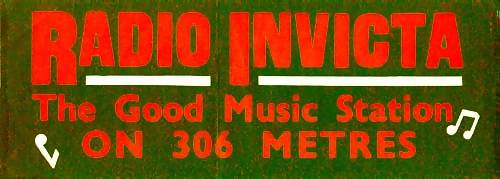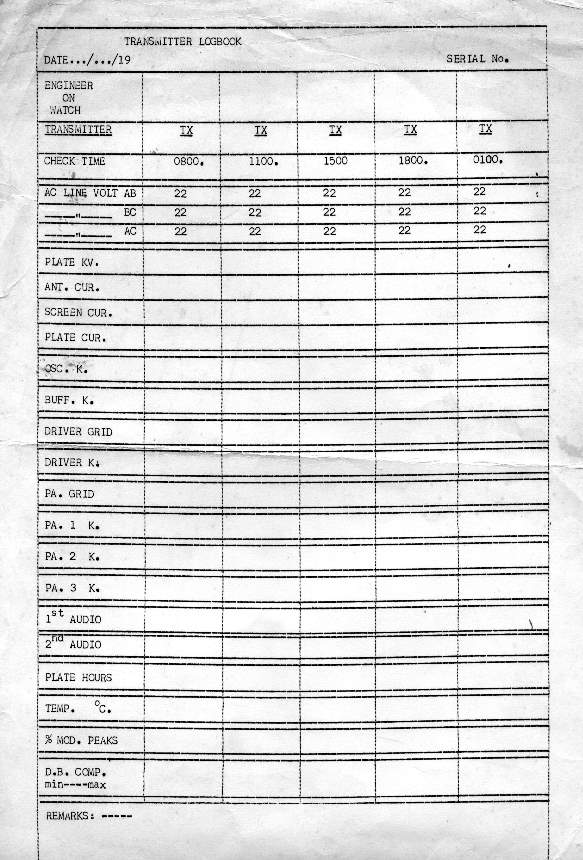Phil Perkins was an engineer on three offshore radio stations of the sixties, as well as an occasional disc-jockey under the name of Tony Silver on two of them.
The Pirate Radio Hall of Fame was delighted to hear from him in April 2020. Like many offshore transmitter engineers, Phil was a radio amateur (call sign G3OUV). He joined his first station,
Radio Invicta, after phoning to complain about the interference its output was causing on the amateur band.

Thanks to Wendy Haberl for this Radio Invicta car sticker.
Phil Perkins: “In August 1964 the late Gerald Hussey and I did a GM3OUV/P trip around Scotland. On return, I switched on my HRO receiver on top band to hear this very strong
music station which I found to be the second harmonic of a weak medium wave Radio Invicta. I remember it gave (station owner) Tom Pepper's home address so it was just a matter of using Directory Enquires to call. I'm sure there was
55033 in the number. I spoke to Tom and he asked me to come and meet him at Folkestone Harbour and go and fix it, not knowing that it was located on the forts.
We travelled to Whitstable and he got one of the shrimp boats to take us out as it was hot, sunny and flat calm. On the way he was telling me about the luxuries like the sun lounge (lol). I assumed that the problem was that
the output tank circuit was not properly tuned but it was a standard pi network and all fine. If you are at all tekky, you will know that a series tuned circuit can be used as a trap. I found a right sized coil and variable
capacitor and put this straight across the antenna output. It was mighty sharp tuning but even locally, on the ship to shore emergency radio that covered top band, you could see the big dip - job done.
The luxury bed was sleeping in the top drawer of a large chest of drawers! Next day Tom signalled a fishing boat with a mirror to get a lift back to Whitstable. That may well have been (tender captain) Vic Davies. I got a train
back to High Wycombe and assumed that was the end of it. The next day I got a call from Tom, confirming all was now OK and offering me a job as the one and only Chief Engineer at a whole £65 per week. The place where I worked
(Ernest Turner Electrical Instruments, Radio Department) couldn't offer anything like that so after discussing it with my now late mum, I took the job. Work was 2 weeks on and 1 week off. This was when fellow radio amateur
Eric Davies (G3PGM) asked me if there were any other jobs going and, after agreeing it with Tom, Eric became second engineer despite his age seniority over me. Unfortunately he decided to jump when
coming through one of the doors and badly split open his head, meaning a call to North Foreland for an emergency chopper.
Sadly the next person to ask to replace Eric was Martin Shaw (G3SDP). It was then approaching Christmas and I was due off on the 16th December. When Tom came out, Martin asked if he could go off instead
so he could be home at Christmas. I agreed, not knowing what would happen.”
(This is a reference to the tragic sinking of Radio Invicta's tender, claiming the lives of Tom Pepper, Martin Shaw and DJ Simon Ashley.)
“DJ Ed Moreno became a great friend and his very first action on coming onboard for the first time was to cut up a thin blanket to make slip mats for record cueing and using
three more to surround the studio to stop the echoes and noises. I think we all slept cooler for those involuntary contributions!
As I was brought up by a single mum who ran a petrol station/garage, the knowledge I picked up before she sold it when I was 11 was what gave me the knowledge to get one of the Gardner diesel generators going on the Invicta north
tower. This immediately let us use the cranes on the towers as all of the wiring was intact from fort to fort. The engines had been quite badly ransacked by fishermen so it took a time to get one going by taking parts off the other
stripped ones to make one intact. It's a real miracle that there were enough parts and you can never appreciate the miracle of achieving that. I shall never forget that generator starting up. I'd made some priming mixture so needless
to say it was like multiple explosions and real scary until the governor kicked in at 1500rpm. This enabled me to suss that the supply was 3 phase Delta (unlike onshore 3 phase star) possibly for ‘safety’ as the highest
voltage you could get was 230v unlike onshore 415v. They had separate smaller generators for the lighting which were DC and either 115 or 150v but Tony flipped the lighting circuits over to 230v to use everyday bulbs. (Later) on
Radio City, my Invicta knowledge enabled me to advise Reg to get a 3 phase delta generator so we could use the crane. Tony Pine built the platform used for lifting people and goods. It was real dodgy when
the sea was rough as the boat was possibly travelling up and down 6 feet or so but the skills of (tender captain) Fred Downs always won. I wasn't just an electronics engineer for the transmitter but all round diesel engineer
too.”
(Radio Invicta continued for a few months before being replaced by King Radio, also known as K.I.N.G.)
“The King takeover was evil as it was my unknowing last time of leaving Red Sands when Vic (Davies) came out with all those strangers. He was instructed to take us on a fishing trip, instead of the usual
direct route to Whitstable, but with the radio on so that we heard the ‘new sound’. That was rather upsetting. I thought that was the end of my offshore days but it wasn't long before (Radio City owner)
Reg Calvert approached me. I wasn't at all lucky with bosses as Major Oliver Smedley shot him in cold blood and got away with it (see ‘The raid on Shivering Sands and death of
Reg Calvert’).”
(Following Reg Calvert's shooting, his widow Dorothy took over the running of Radio City but the station was forced to close in February 1967 when a court decided it was broadcasting from UK territorial waters.)
“Mrs Calvert was a good boss and then, after the Bays Act (closed Radio City), I was approached by Radio Caroline North. That was a bit boring but most of the time, when not taking the (possibly) 4 hourly
transmitter meter readings, I used to catch lovely fresh cod and mackerel. That's where I got introduced to Heineken in the form of a ration of 24 x 330ml bottles per week! (Fellow engineer) Mike Wright
(EI2DJ) and I shared the fags and booze. Good old days.”
|

|
|
The log that Phil was supposed to complete with transmitter readings every few hours when working for Radio Caroline. Form kindly contributed by Mike Wright.
|
Many thanks to Phil for sharing his memories.
Back to the memorabilia index.
|

